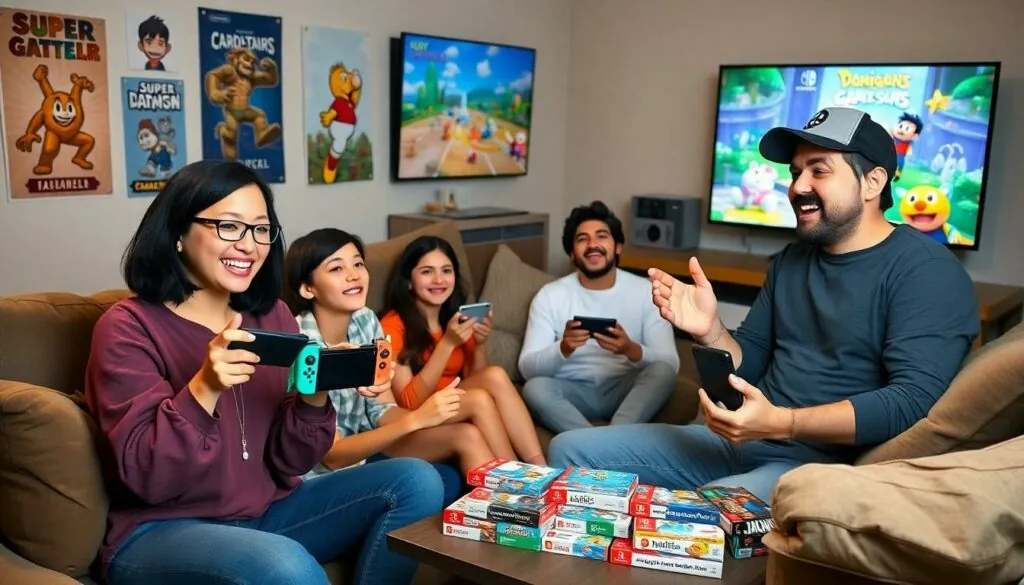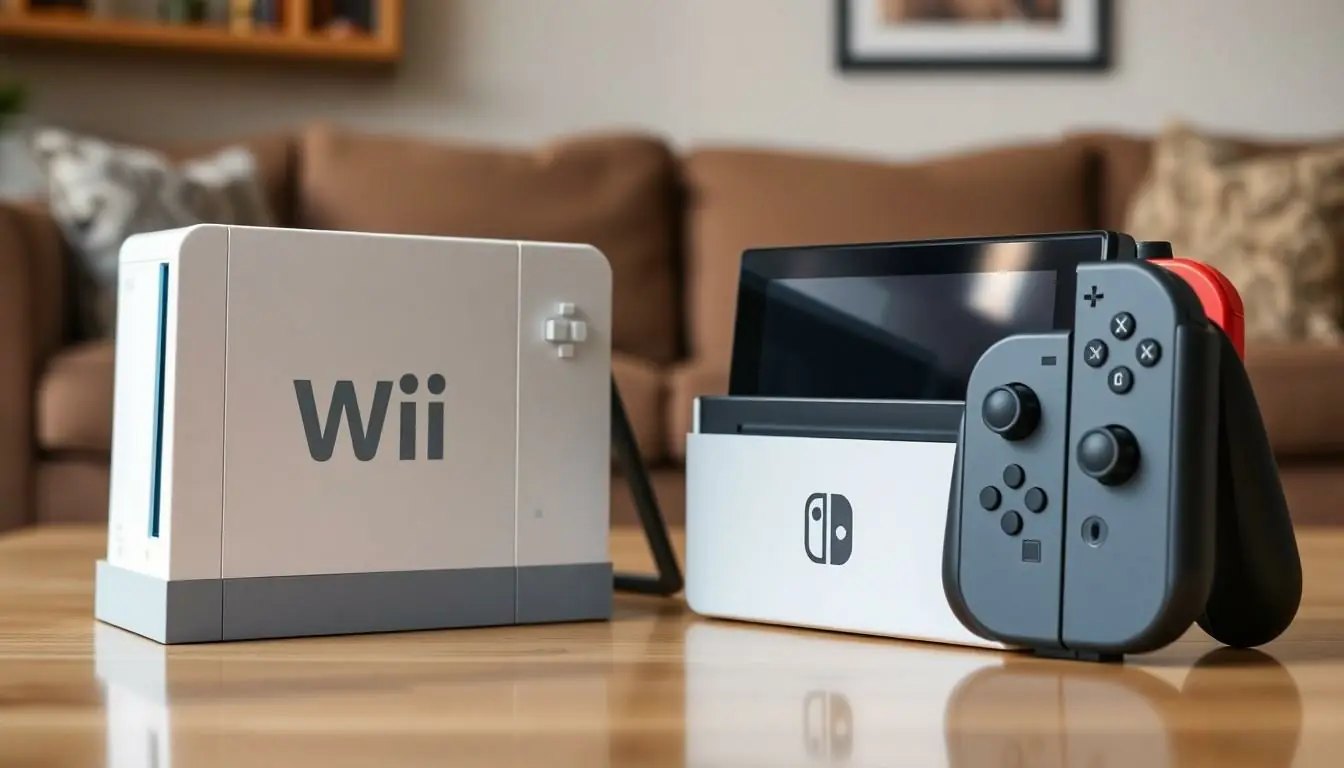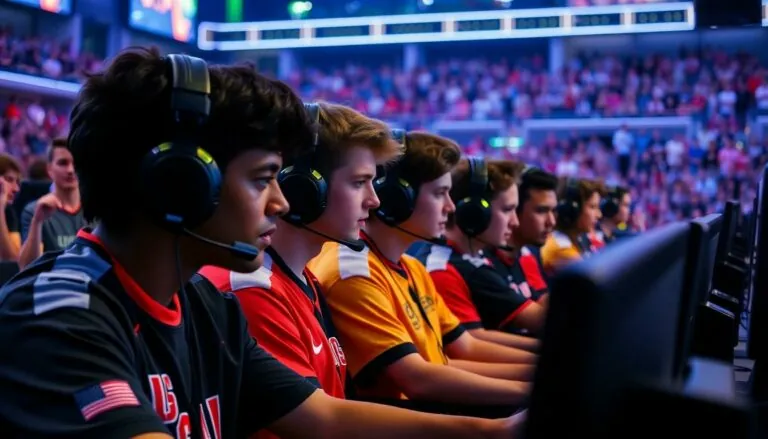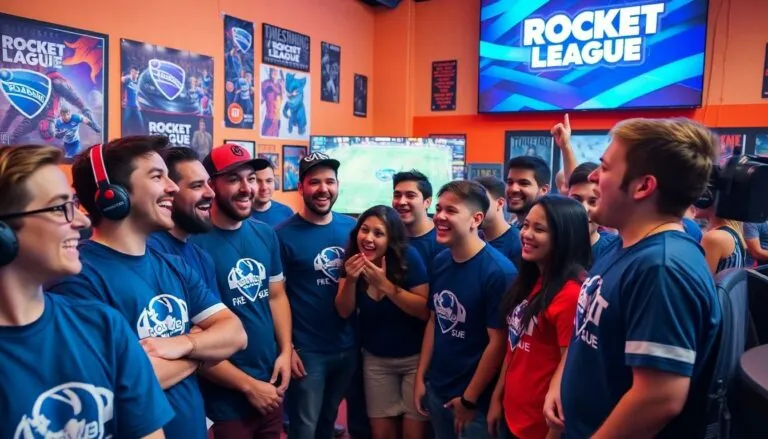When it comes to gaming, few names spark nostalgia quite like Nintendo. The Wii and Switch have both carved their own legacies, each offering unique experiences that keep players coming back for more. The Wii revolutionized motion gaming, turning living rooms into dance floors and fitness studios. Meanwhile, the Switch introduced hybrid gaming, letting players take their adventures on the go or on the couch.
Table of Contents
ToggleOverview of Nintendo Wii and Switch
Nintendo’s Wii launched in 2006, setting a new standard for interactive gaming. The console incorporated motion controls, allowing players to physically engage with games. It attracted a diverse audience, appealing to both casual and hardcore gamers. Titles like “Wii Sports” showcased its family-friendly appeal, drawing groups together for fun.
In contrast, the Nintendo Switch debuted in 2017, introducing hybrid gaming capabilities. This console allows players to switch from handheld to docked mode, offering flexibility. The portability feature enhances gaming experiences on the go. Popular games on the Switch like “The Legend of Zelda: Breath of the Wild” and “Animal Crossing: New Horizons” demonstrate its versatility and appeal to different demographics.
Graphics quality also marks a significant difference. Wii games focused on accessibility with simpler graphics, making them approachable. Switch games deliver enhanced graphics and performance, providing a more immersive experience. Both consoles feature exclusive titles that leverage their unique strengths, capturing player interest.
Community engagement matters for both systems. Online play on the Switch facilitates connections among friends and strangers. Wii fostered local multiplayer experiences, often bringing family and friends together in the same room. Each console contributed to the gaming landscape in distinct ways.
Nintendo’s strategic shifts reflect changing consumer preferences. The Wii emphasized motion gameplay while the Switch embraced hybrid functionality. Each console’s design philosophy reflects Nintendo’s adaptation to evolving gaming trends. Collectively, they showcase Nintendo’s innovation and commitment to enhancing player experiences.
Key Features Comparison
Both the Nintendo Wii and Switch showcase remarkable features that appeal to various gaming audiences. Each console brings unique strengths to the table.
Graphics and Performance
Graphics quality varies significantly between the two consoles. The Wii emphasizes accessibility with simpler graphics that prioritize gameplay over visual fidelity. Game titles like “Wii Sports” reflect this focus. On the other hand, the Switch offers enhanced graphics through its more advanced hardware. Popular games such as “The Legend of Zelda: Breath of the Wild” demonstrate the Switch’s ability to deliver a visually immersive experience, boasting higher resolution and richer colors. Performance-wise, the Switch supports smoother frame rates, catering to both handheld and docked modes. Increased processing power allows for more detailed environments and textures.
Design and Build
Design differences highlight the evolution of Nintendo’s hardware. The Wii features a compact, minimalist design that fits easily into any entertainment setup. Its simplicity appeals to casual gamers and families. Contrastingly, the Switch incorporates a hybrid design, combining portability and versatility. The detachable Joy-Con controllers enhance gameplay flexibility. Additionally, the Switch’s larger screen caters to on-the-go gamers while still functioning well when docked for home play. Build quality also differs, with the Switch utilizing more premium materials, enhancing durability and user experience.
Controller Differences
Controller designs set the Wii and Switch apart significantly. The Wii’s motion-sensitive remote introduced a new way of gaming through physical interaction, allowing players to mimic real-world actions. Traditional gaming mechanics, like button pressing, are secondary with this approach. Conversely, the Switch features multiple controller options, including Joy-Con and Pro Controller configurations. Joy-Cons enable motion controls akin to the Wii, yet also support traditional gameplay. This dual approach caters to a wide array of preferences, making the Switch adaptable for various gaming styles. The ergonomic design of the Pro Controller enhances comfort during extended play sessions.
Game Library
The game libraries of the Nintendo Wii and Switch highlight their unique strengths and appeal to different audiences.
Exclusive Titles on Wii
The Wii features iconic exclusive titles that defined its era. “Wii Sports” revolutionized gaming with simple yet engaging motion controls. Family and friends enjoyed countless hours playing sports like tennis and bowling. “Super Mario Galaxy” showcased innovation in platforming, featuring gravity-defying gameplay that captivated players. Titles such as “The Legend of Zelda: Skyward Sword” pushed the boundaries of adventure gaming, utilizing motion controls for immersive puzzles and combat. Gamers appreciated the accessibility and family-friendly nature of the Wii’s lineup, making it a staple in households.
Exclusive Titles on Switch
Switch exclusive titles set a new standard for gaming experiences. “The Legend of Zelda: Breath of the Wild” garnered widespread acclaim for its vast open world and exploration. Players enjoyed unprecedented freedom in gameplay, redefining action-adventure standards. “Animal Crossing: New Horizons” emerged as a cultural phenomenon, offering a relaxing simulation for players of all ages. Innovative gameplay and charming aesthetics drew millions. Additionally, “Splatoon 2” introduced a fresh take on multiplayer shooting games, focusing on creativity and teamwork. The Switch’s exclusive titles reflect its versatility, appealing to diverse gaming preferences and enhancing its vibrant library.
User Experience
User experience on the Nintendo Wii and Switch varies significantly, influencing player preferences and engagement.
Online Capabilities
Nintendo Switch excels in online capabilities, offering a robust online service called Nintendo Switch Online. This service provides access to online multiplayer for various games, cloud saves, and a library of classic NES and SNES titles. Players connect easily with friends for co-op or competitive gameplay, a step up from the Wii’s limited online functionality. The Wii featured minimal online elements, primarily focused on friend codes and limited game support. Consequently, the Switch fosters a more immersive online environment that enhances community interaction and gameplay variety.
Multiplayer Options
Multiplayer options showcase contrasting experiences between the Wii and Switch. The Wii thrives on local multiplayer, encouraging friends and families to gather around the console for interactive fun. Popular titles like “Mario Kart Wii” and “Super Smash Bros. Brawl” emphasize local competition. The Switch introduces both local and online multiplayer, expanding game options significantly. Detachable Joy-Con controllers make it easy to play with friends anytime, anywhere. Games such as “Splatoon 2” and “Super Mario Party” highlight the Switch’s versatility in catering to multiplayer experiences. Those who prefer cooperative or competitive play find a welcoming environment across both consoles.
Market Impact and Legacy
The Nintendo Wii reshaped the gaming landscape upon its release in 2006. Its motion controls drew in a diverse audience, making gaming accessible to families and non-gamers. Sales figures reflect its success, with over 100 million units sold worldwide by 2013. Engaging titles like “Wii Sports” enabled social interactions in living rooms, creating memorable experiences for players of all ages.
Conversely, the Nintendo Switch, launched in 2017, introduced groundbreaking hybrid gaming. Allowing players to switch between handheld and docked modes, it strengthened accessibility and flexibility in gaming. Within just four years, the Switch surpassed 100 million units sold, indicating its widespread popularity. Acclaimed games such as “The Legend of Zelda: Breath of the Wild” and “Animal Crossing: New Horizons” set new benchmarks for gameplay quality, appealing to both casual and hardcore gamers.
Graphics quality varies significantly between both consoles. The Wii prioritized engaging gameplay over visual fidelity, utilizing simpler graphics that resonated with its audience. In contrast, the Switch boasted enhanced graphics capabilities, delivering more immersive experiences with detailed environments and smooth frame rates.
Community engagement also evolved. The Wii fostered local multiplayer fun, encouraging gatherings around the console. Online functionalities remained limited, with minimal gameplay options beyond local play. Meanwhile, the Switch focused on improved online services, including Nintendo Switch Online, facilitating seamless multiplayer experiences and cloud saves. This shift redefined how players connect, allowing for co-op and competitive play, regardless of location.
The game libraries further illustrate their distinct legacies. Iconic Wii titles, including “Super Mario Galaxy” and “The Legend of Zelda: Skyward Sword,” defined its era with innovative motion gameplay. In contrast, the Switch’s library features a broader range of genres, addressing various gaming preferences and solidifying its lasting impact on the industry.
Conclusion
Both the Nintendo Wii and Switch have left indelible marks on the gaming landscape. The Wii’s innovative motion controls brought families together and redefined interactive gaming. Its success in creating social experiences is undeniable.
On the other hand, the Switch has taken gaming to new heights with its hybrid design and expansive game library. It caters to a diverse audience while enhancing portability and online engagement. Each console reflects Nintendo’s ability to adapt to changing player needs.
Ultimately, the choice between the Wii and Switch hinges on personal preferences. Whether one values nostalgic local multiplayer experiences or the versatility of hybrid gaming, both consoles showcase Nintendo’s commitment to delivering unforgettable gaming experiences.







